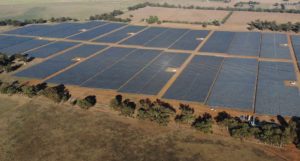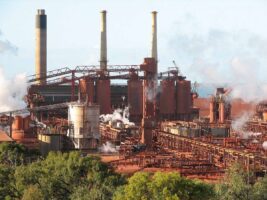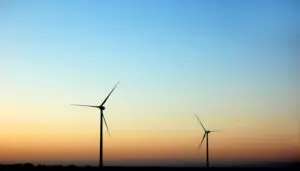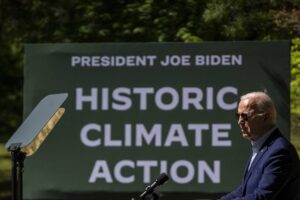The shift towards green hydrogen-based direct reduced iron (DRI) processes is widely considered a key step in the global steel sector’s decarbonisation pathway.
While supply of suitable direct reduction-grade iron ore is a potential headwind, developments in mining and processing combined with technology solutions present a path to zero-emissions DRI.
The current dominance of coal-consuming blast furnace operations gives iron ore miners an incentive to continue producing blast furnace-grade iron ore, rather than DR-grade ores with higher iron content. Remedies include developing mines that can produce high-quality ores and new technology configurations that allow use of blast furnace-grade ore in DRI processes.
Global interest has increased in green hydrogen’s use as a zero-emissions fuel, potentially playing a significant role in decarbonisation. Green hydrogen can replace fossil fuel-derived hydrogen and carbon monoxide in DRI steelmaking, eliminating carbon dioxide emissions.
It’s not just theory. European steel manufacturers are starting to plan industrial-scale DRI projects that will eventually use green hydrogen.
As green hydrogen is currently costlier than fossil fuel-based hydrogen, much of the attention given to the future of zero-carbon DRI technology is on the scaling up of green hydrogen production and the approaching date at which it becomes cost-competitive.
But DRI, currently accounting for only a small fraction of crude steel production, also requires a higher grade of iron ore than blast furnaces, the dominant global process. DR-grade iron ore ideally has an iron (Fe) content of 67% or more. Such deposits are scarce, however.
Many net-zero emissions pathways for the steel sector anticipate much of the decarbonisation process happening after 2030. However, about 71% of existing global blast furnace capacity will reach the end of its operational lifetime before 2030.
To avoid locking in further coal-based steelmaking capacity for decades, some technology switching to DRI-electric arc furnace (EAF) processes will be required before then.
Potential new DR-grade iron ore capacity by 2030 ranges from 40 million tonnes per annum (Mtpa) to an optimistic high of 100Mtpa. Unless technology innovations allow use of lower-grade ore, on current projections for a net-zero steel sector by 2050, DR-grade supply may need to increase tenfold.
The very long lead times for new iron ore projects and technical barriers however limit the ability of miners to quickly change their product quality mix. Outside of the big four mining companies, iron ore projects that could potentially increase supply of DR-grade ore are often in early stages.
BHP’s focus is on lower emissions from blast furnaces. The company has stated that it believes blast furnace-based steelmaking will remain dominant even in 2050 based on the scarcity of deposits of high-quality iron ore.
Similarly, Rio Tinto’s first phase of steel industry decarbonisation is on reducing emissions from blast furnaces that use its relatively lower grade but highly profitable Pilbara iron ores.
Fortescue Metals Group’s Iron Bridge project, due to start production at the end of 2022, could potentially add to the DR-grade iron ore supply. However, the company has noted that Iron Bridge output could be blended with lower-grade ores to produce an improved blast furnace ore.
Vale, the largest supplier of high-grade iron ore pellets for DRI plants and blast furnaces, cites the challenges of beneficiation process (improving ore quality via grinding, separation and dewatering) and depletion of high-grade iron ore reserves that make it difficult to increase supply of DR-grade ores. Vale forecasts a shift towards higher quality iron ore over the rest of this decade but no change in the minor proportion of seaborne DR-grade.
Among options to address DR-grade availability is a significant switch in iron ore mining focus from hematite towards magnetite. Hematite currently dominates iron ore mining – the bulk of direct shipping ores (DSO) are hematite such as Australia’s Pilbara mid-grade iron ore.
Magnetite ores tend to have a much lower Fe content but are often suitable for significant beneficiation — in part because magnetite is magnetic which can make separation easier — to DR-grade.
There is also renewed interest in making Pilbara ores suitable for low-emissions steel — the Heavy Industry Low-carbon Transition Cooperative Research Centre (HILT-CRC) has a program on the production of green iron products from Pilbara iron ores.
A promising solution to the iron ore quality issue involves new technology combinations.
Increasing DRI production with lower-grade iron ore will necessitate melting the reduced iron before being charged into a basic oxygen furnace – a technology combination being investigated by Rio Tinto in partnership with BlueScope Steel as well as ArcelorMittal.
More advanced than either of these is Thyssenkrupp which plans to begin replacing blast furnaces with DRI plants with integrated melting units from 2025. Thyssenkrupp will be able to use blast furnace-grade ores in its DRI processes using this technology pairing.
In the longer term, there are potential new processes such as iron ore electrolysis which is not limited to using high-grade ore. BloombergNEF foresees this early-stage technology reaching commercial readiness by 2035.
Technology to cut steelmaking emissions is in the early stages but such transitions can accelerate, as evidenced by the fast maturation of wind and solar power. Expensive a decade ago, these are now set to dominate power generation additions.
Steel has a reputation as a “hard to abate” sector and the challenge imposed by limited DR-grade iron ore supply on plans for a large global scale-up of DRI production is significant. The focus on potential solutions must increase immediately.
Simon Nicholas and Soroush Basirat, IEEFA
Read IEEFA Asia Pacific’s new report: Iron Ore Quality a Potential Headwind to Green Steelmaking – Technology and Mining Options Are Available to Hit Net-Zero Steel Targets









